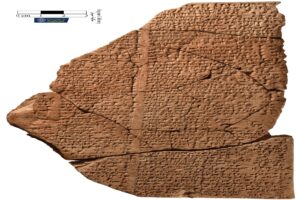Archeologists working in the small English village of Harpole, Northamptonshire this spring discovered a female burial site that includes a 30-piece necklace of unprecedented craftsmanship and value for the period and location.
Been seeing the Harpole Treasure in the news?
Let’s talk about this amazing discovery, what it means and what will happen next. We’ll also introduce you to some of the team involved! pic.twitter.com/x60nSHVZKH
— MOLA (@MOLArchaeology) December 7, 2022
“This is a find of international importance,” Museum of London dig leader Levente Bence Balazs gushed to The Guardian. “This discovery has nudged the course of history…There’s so much still to discover about what we’ve found and what it means.”
The mysterious discoveries in question include a glass, gold, and garnet necklace made of 30 pendants, as well as pots filled with an unidentified residue. Scientists also found a large silver and gold cross inscribed with depictions of human faces — an unusual practice for the time.
The burial site dates to between 630 and 670 AD and is “one of the most spectacular Early Medieval female burials ever found in England,” according to a tweet by the Museum of London Archaeology.
“[The necklace] is the richest example of its kind,” the post continued.
An early Christian leader
The cross motif of the necklace’s central pendant, as well as the other Christian iconography at the burial, led Museum of London archaeologists to suspect that the woman was an early Christian leader. And while only the crowns of her teeth remain, experts are positive that their find was, in fact, a woman.
“Women have been found buried alongside swords, but men have never been found buried alongside necklaces,” team specialist Lyn Blackmore shared with The Guardian.
We did find other grave goods – we’re most excited about a large silver and gold cross that appeared in x-rays! It appears to be related to small silver human faces.
Experts including our Specialist Lyn Blackmore believe this woman was almost certainly an early Christian leader. pic.twitter.com/7GHeT606jA
— MOLA (@MOLArchaeology) December 7, 2022
An unexpected find
The Museum of London Archeology team had no reason to suspect that anything of real value was buried in the area. They were in Harpole because of a routine practice known as developer-funded archaeology. Here, property developers loop archaeologists into the planning process and fund digs if necessary. The process allows scientists to be more intentional about planning digs rather than having to rush to a site when machinery unearths artifacts.
According to The Guardian, a development firm called The Vistry Group commissioned the initial search, hoping to build houses in the (unidentified to the public) area. The scientists didn’t discover much of interest. Then, on the last day of the dig, Balazs stumbled upon the amazing artifacts while excavating what he thought was a pile of 1,000-year-old trash.
“I was looking through a suspected rubbish pit when I saw teeth,” the archaeologist said. “Then two gold items appeared out of the earth and glinted at me. These artifacts haven’t seen the light of day for 1,300 years, and to be the first person to see them is indescribable. But even then, we didn’t know quite how special this find was going to be.”
Under the rules of developer-funded archaeology, Vistry technically had rights to the treasure. But the firm waived those rights in favor of donating the find to the state. Museum experts suspect it will take at least two years to fully conserve the artifacts, after which they hope to display them locally.
Not bad for a little town whose name means “filthy pool.”






